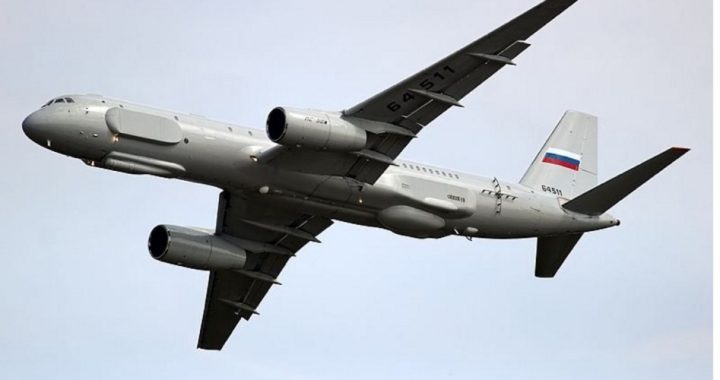
According to the Associated Press, Russia is about to ask permission of the Open Skies Consultative Commission (OSCC) in Vienna, Austria, to fly its latest reconnaissance aircraft, the Tu-214ON (shown), over the United States. The airplane will have the latest in spy technology, including video, optical panoramic and framing cameras for daylight photography; infrared line scanners, giving it day/night capabilities; synthetic aperture radar, providing it day/night/all-weather capabilities, along with its “digital electro-optical sensor.” Image quality, thanks to the latest digital technologies, will allow Russian analysts the ability to distinguish between a military tank and an 18-wheeler from miles above U.S. territory.
It’s making U.S. military officials nervous. Admiral Cecil Haney, commander of the U.S. Strategic Command, wrote: “The [Treaty on Open Skies] has become a critical component of Russia’s intelligence collection capability directed at the United States,” adding:
In addition to overflying military installations, Russian Open Skies flights can overfly and collect on Department of Defense and national security … critical infrastructure. The vulnerability exposed by exploitation of this data and the costs of mitigation [of such exploitation] are increasingly difficult to characterize.
Rose Gottemoeller, under secretary of state for Arms Control and International Security, pooh-poohed such concerns, stating that it’s probable that any information Russia will obtain from the reconnaissance flights will only be “incremental” to what they already collect “from other means.” In addition, she said, any information Russia obtains will have to be shared with the United States:
One of the advantages of the Open Skies Treaty is that information — imagery — that is taken is shared openly among all [34] treaty parties.
So one of the advantages … is that we know exactly what the Russians are imaging, because they must share [that] imagery with us.
There are several difficulties with this disclaimer, according to Lt. Gen. Vincent Stewart, director of the Defense Intelligence Agency. During a congressional hearing, Stewart told the committee, “The Open Skies construct was designed for a different era. I’m very concerned about how it’s applied [by Russia] today.” Deputy Secretary of Defense Robert Work told Congress separately that Russia is “going beyond the original intent of the treaty.… We continue to look at this very, very closely.”
Steve Rademaker, former assistant secretary of state and now the principal of the Podesta Group, told a group last October that Russia “has adopted a number of measures that are inconsistent with the spirit” of the treaty.
Among those measures is Russia’s unwillingness to let the OSCC grant permission for other treaty members to fly over Moscow or Chechnya, as well as Kaliningrad, the administrative center of Kaliningrad Oblast, a Russian enclave between Poland and Lithuania on the Baltic Sea. Russian officials have also deemed off-limits two areas in “frozen conflict” (no active shooting at the moment, but no treaty either): Abkhazia, located on the eastern coast of the Black Sea, and South Ossetia, in Russia’s South Caucasus.
This is evidence, according to Rademaker, that Russia is “selectively implementing” the Open Skies Treaty “in a way that suits its interests.”
Another difficulty is that Russia and the United States have continuing disagreements over Russia’s interventions in Syria and the Ukraine.
The idea of mutual aerial surveillance was the brainchild of President Dwight Eisenhower, who presented it for consideration to Soviet Premier Nikolai Bulganin in 1955. It lay dormant for 34 years until President George H.W. Bush resurrected it as a way to build confidence and trust between NATO and Warsaw Pact countries. Secretary of State James Baker signed it in Helsinki in March 1992 and it became effective in January 2002. The first aerial surveillance flights began in August of that year, and have continued since.
Until the end of WWII, the United States refused by and large to be drawn into international treaties, agreements, and alliances, following the guidance and wisdom of George Washington and Thomas Jefferson. In Washington’s farewell address, he said: “It is our true policy to steer clear of permanent alliance with any portion of the foreign world,” while Jefferson, in his inaugural address put it this way: “Peace, commerce, and honest friendship with all nations — entangling alliances with none.”
Today the United States has entangling alliances with nearly every country on the planet, resulting in the allegedly unintended consequences of such alliances as the Treaty on Open Skies which further abridge our national security, as well as our national sovereignty.
Photo of Tu-214ON: Rimma Sadykova
A graduate of an Ivy League school and a former investment advisor, Bob is a regular contributor to The New American magazine and blogs frequently at LightFromTheRight.com, primarily on economics and politics. He can be reached at [email protected].



